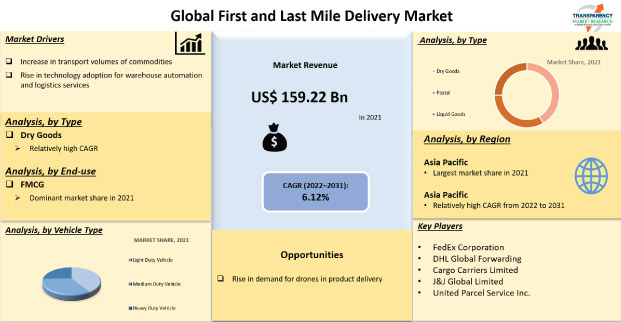
First mile refers to the movement of products from a retailer to a courier service, or to anyone who is expected to transport goods to their final users, while the last mile refers to the final movement of products to their final intended users. First mile delivery can be simply termed as the last mile delivery for a vendor/ manufacturer.
Delivery service can be defined as the transportation of a parcel or package from its origin that travels through the pickup chain, transit chain, and delivery chain in order to reach to its destination. First mile delivery service is the first part in the delivery system that falls between the pickup chain and transit chain, while last mile delivery service is the final part where the parcel is handed over to the end-consumer. This falls under transit chain and destination.

Increasing number of last mile and first mile delivery companies and startups are offering a bright ray of hope for the logistics industry, as first and last mile delivery service has major applications in the logistic industry. Increase in population across the globe fuels the consumption and supply of food and other goods. Furthermore, economic expansion in developing and developed countries in the last few years has led to a surge in transport volumes of commodities from one place to another. This, in turn, is anticipated to boost the first and last mile delivery market during the forecast period. Additionally, rapid expansion in transport facilities, due to advancements in technology and booming urbanization over the years, has led to a rise in transport of goods and commodities. Rising penetration of smartphones and access to speedy internet services have boosted consumer preference toward online shopping. This, in turn, is anticipated to propel the first and last mile delivery market during the forecast period.
Asia Pacific is a leading market for first and last mile delivery, globally, as a large population in the countries from the region provide a major consumer base for expansion of the online retail industry. Expansion of the online retail industry boosts transportation services that provide first and last mile delivery service. Young innovative minds in Asia Pacific focus on the service industry as their main source of income. Small players are emerging from the region, as start-ups provide delivery service within the city from storage hubs to the consumer’s door. Asia Pacific is followed by Europe, in terms of share, owing to higher per capita income, increased usage of advanced technology products and services, and being the second-most populous region.
The first and last mile delivery market is majorly influenced by technology. Automation in the delivery process is likely to introduce various technological products that are efficient in performing the tasks done by labourers and delivery boys. Technological products, such as robots and drones, are being used for small parcels. Moreover, for larger packages, there is rise in frequency which is carried with the help of truckload and less-than-truckload transporters. White-glove services that involve other parts of the supply chain, apart from delivery, i.e., setup, assembly, and installation, are rapidly expanding. Sophisticated computer technology is another most important aspect that is driving the technology involved in the first and last mile delivery services and ultimately, boosts the first and last mile delivery market. For instance, in 2015, Amazon founder and CEO Jeff Bezos announced that delivery drones by Amazon are not to be introduced in upcoming years; however, delivery drones are likely to be a common mode of parcel transportation in the next decade. UPS is another major player in the market who is trying out delivery drones.
Disadvantages associated with automation in the first and last mile delivery services include an increase in the rate of unemployment, as labourers and delivery boys are replaced by drones and robots. India, Brazil, and countries in ASEAN have a higher rate of unemployment rate are likely to be more affected by the introduction of technology, which in turn is projected to hamper the market for first and last mile delivery.
Ask for brochure:
https://www.transparencymarketresearch.com/sample/sample.php?flag=B&rep_id=60984
Major players operating in the global first and last mile delivery market include Cargo Carriers Limited, FedEx Corporation, United Parcel Service Inc., Tuma Transport, Swift Transport, Interlogix Pty. Ltd., Transtech Logistics, Procet Freight, Concargo Private Limited, J&J Global Limited, DB SCHENKER, DHL Global Forwarding, TNT Express, Kerry Logistics Network Limited, and KART. Numerous other small players are operating in the first and last mile delivery market in various countries, as entry into the market does not require significant initial establishment cost. These small players hold a majority share of the total first and last mile delivery market. A majority of consumers prefer these small players, as they charge less as compared to key players. Moreover, smaller players are focused only on a particular city, which enables highly effective delivery service, such as one-day delivery and good handling of the parcel.
Read TMR Research Methodology at: https://www.transparencymarketresearch.com/methodology.html
Read Our Latest Press Release:
- https://www.prnewswire.com/news-releases/rapid-adoption-of-cloud-based-platforms-to-benefit-companies-in-the-global-tax-software-market-whilst-outbreak-of-covid-19-to-accelerate-use-of-digital-platforms-for-tax-filing-processes-tmr-301249303.html
- https://www.prnewswire.com/news-releases/advantages-of-precise-allocation-of-energy-costs-for-commercial-residential-establishments-spurs-growth-in-electric-sub-meter-market-digital-metering-solutions-witness-substantial-uptick-in-demand—tmr-301243186.html
- https://www.prnewswire.com/news-releases/scrap-metal-recycling-market-to-emerge-robust-from-headwinds-of-covid-19-market-projected-to-expand-at-notable-6-cagr-from-2020—2030-301239593.html





